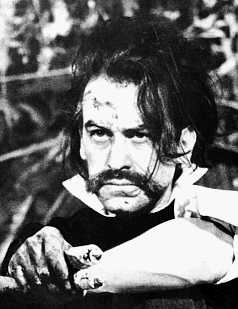About Georges Mathieu
 Georges Mathieu was born on January 27, 1921, in Boulogne-sur-Mer, France, of Mr. Adolphe Mathieu d’Escaudœuvres and Mrs. Madeleine Dupré d’Ausque. He passed away 10 June 2012 Boulogne-Billancourt. He was a French abstract painter, art theorist, and member of the Académie des Beaux-Arts in Paris.[1] He is considered one of the fathers of European lyrical abstraction, a trend of informalism.
In 1947, he settled in Paris, employed the American Express, and rented a chambre de bonne near the Luxembourg Palace.
Mathieu then worked for the United States Lines in charge of public relations on the line between New York City and Le Havre: his function was to welcome and accompany the travelers during their move between Le Havre and Paris. This position was an opportunity for Mathieu to reach a prestigious clientele, and form his first network of potential customers. He meets Salvador Dalí for the first time on his occasion.
From 1957 he traveled and painted in Japan, the USA, and in 1959 in Brazil, Argentina, and Middle-East. Retrospectives of his work started as early as 1959.
Mathieu and Simon Hantaï held a series of conferences called the Cérémonies commémoratives de la seconde condamnation de Siger de Brabant in 1957. During three weeks, various debates questioned the foundations of western civilizations, the role of the great men and revolutions that shaped the western culture from the Edict of Milan in 313 up to the contemporary breakthroughs in physics and philosophy. Many scholars like essayist T.S. Eliot, philosopher Stéphane Lupasco and scientists took a stand at these conferences. The event was named after the philosopher Siger de Brabant, who played a key role in the 13th-century.
In 1965, Mathieu exposed a hundred paintings at the Galerie Charpentier. He executed for this event Paris, Capitale des Arts, a giant canvas featuring primary colors on a blue background. Today, Galerie Charpentier's walls house the headquarters of Sotheby's France, rue Faubourg Saint-Honoré in Paris.
A great retrospective at the Grand Palais opened in 1978 and covered the fifteen last years of his production. Seven six meters wide paintings, executed from January to March 1978, were made especially for the occasion.
He received the Legion of Honour and is Commander of Arts and Letters. Mathieu's works now appears worldwide in more than 90 museums.
In 1976 he became a member of the Academie des Beaux-Arts and was delivered the seat number 7 of the painting section.
From 1947 Mathieu published several manifestos to define his conception of lyrical abstraction. In particular, he postulates four conditions that characterize the movement.
Mathieu positions its work, and more generally lyrical abstraction, as the latest of all cyclical transitions to happen in the history of art. Each transition concerns a specific painting characteristic: shape, color, the signification of signs, ...). One full transition can be broken down into six different stages, according to the intensity of the alteration of the considered painting characteristic.
Georges Mathieu was born on January 27, 1921, in Boulogne-sur-Mer, France, of Mr. Adolphe Mathieu d’Escaudœuvres and Mrs. Madeleine Dupré d’Ausque. He passed away 10 June 2012 Boulogne-Billancourt. He was a French abstract painter, art theorist, and member of the Académie des Beaux-Arts in Paris.[1] He is considered one of the fathers of European lyrical abstraction, a trend of informalism.
In 1947, he settled in Paris, employed the American Express, and rented a chambre de bonne near the Luxembourg Palace.
Mathieu then worked for the United States Lines in charge of public relations on the line between New York City and Le Havre: his function was to welcome and accompany the travelers during their move between Le Havre and Paris. This position was an opportunity for Mathieu to reach a prestigious clientele, and form his first network of potential customers. He meets Salvador Dalí for the first time on his occasion.
From 1957 he traveled and painted in Japan, the USA, and in 1959 in Brazil, Argentina, and Middle-East. Retrospectives of his work started as early as 1959.
Mathieu and Simon Hantaï held a series of conferences called the Cérémonies commémoratives de la seconde condamnation de Siger de Brabant in 1957. During three weeks, various debates questioned the foundations of western civilizations, the role of the great men and revolutions that shaped the western culture from the Edict of Milan in 313 up to the contemporary breakthroughs in physics and philosophy. Many scholars like essayist T.S. Eliot, philosopher Stéphane Lupasco and scientists took a stand at these conferences. The event was named after the philosopher Siger de Brabant, who played a key role in the 13th-century.
In 1965, Mathieu exposed a hundred paintings at the Galerie Charpentier. He executed for this event Paris, Capitale des Arts, a giant canvas featuring primary colors on a blue background. Today, Galerie Charpentier's walls house the headquarters of Sotheby's France, rue Faubourg Saint-Honoré in Paris.
A great retrospective at the Grand Palais opened in 1978 and covered the fifteen last years of his production. Seven six meters wide paintings, executed from January to March 1978, were made especially for the occasion.
He received the Legion of Honour and is Commander of Arts and Letters. Mathieu's works now appears worldwide in more than 90 museums.
In 1976 he became a member of the Academie des Beaux-Arts and was delivered the seat number 7 of the painting section.
From 1947 Mathieu published several manifestos to define his conception of lyrical abstraction. In particular, he postulates four conditions that characterize the movement.
Mathieu positions its work, and more generally lyrical abstraction, as the latest of all cyclical transitions to happen in the history of art. Each transition concerns a specific painting characteristic: shape, color, the signification of signs, ...). One full transition can be broken down into six different stages, according to the intensity of the alteration of the considered painting characteristic.


